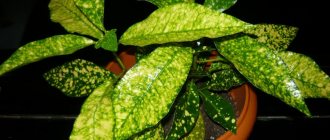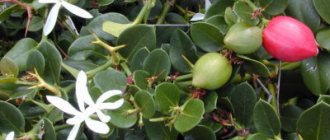Photo: Pixabay Ficus, despite its exotic origin, has been known in our area for a long time. Over the past years, he managed to become a symbol of philistinism, seemingly go out of fashion forever and regain popularity. Ficus is considered unpretentious, but the plant still requires some care. If you want to know what a plant looks like, what it likes, and in what conditions it grows best, check out our article.
Features of ficus
Ficus plants are united by several facts. Firstly, 90% of plants in the family are evergreens. Only 10% are deciduous. Secondly, domestic ficus , like its wild relatives, has whole leaves. This is a single “canvas” with a smooth edge.
Ficus leaves are often rounded. The shape resembles a circle and is associated with coins. Therefore, in Asia, for example, trees of the family are grown as money talismans.
The inflorescences of plants resemble balls or pears in shape. Buds develop on the inner surface. Flowers are usually small and light-colored. They are pollinated by hymenoptera insects, although ficuses reproduce, as a rule, vegetatively. Plants of the family easily form aerial roots. They become the basis for new trees.
House ficus blooms with small white flowers
Unites ficuses and habitat. Plants of the family prefer the tropics. You can find 800 species there. Rare varieties of ficus live in the subtropics. About 100 species were discovered there.
The names of ficus trees are different, but they have common features. Thus, plants are distinguished by the presence of milky juice in all their parts. The viscous elixir is found in the trunks, leaves, and roots. Some species also serve as a source of shellac. It is produced by the lacquer bug.
This insect lives in some ficus trees. The nutritional value of plants is clear from the example of the fig tree. Ficuses are also used in folk medicine. Tree sap eliminates benign uterine tumors. The medicine also fights mastopathy. In the first case, the juice is drunk, in the second, it is rubbed into the chest.
Indian laurel
Native to Asia and Australia, Ficus microcarpa is classified as a ficus tree. Planted as an open ficus, Indian Laurel should grow in subtropical and tropical climates. This type can be pruned, used as an ornamental tree, or to form an extensive crown that provides shade in gardens.
Because Indian Laurel requires a warm, moist environment, Microcarpa varieties are popular as houseplants. Indian Laurel has also become a popular type of miniature tree in bonsai art.
Types of ficus
Only 7 ficus trees are grown at home. The photo of the Dwarf variety only vaguely resembles powerful tropical trees. A tiny plant, a creeping shrub. Its leaves differ in tone and are variegated. Young plants have delicate, non-symmetrical foliage. In adult bushes it becomes thick, dense, and acquires the correct shape.
The tiny ficus belongs to the category of ampelous ones. All of them are spectacular in hanging flowerpots, but are finicky to care for.
Tiny ampelous ficus
It's easier to get a ficus benjamina . It is also creeping, but can also take on the outline of a tree. To do this, it is enough to weave thin trunks. Gradually, they will grow together, forming a single and powerful crown base.
can easily be trimmed at home This simplifies crown formation. The foliage is small and pointed at the ends. The grooves allow excess moisture to drain from the flower. Benjamin's homemade ficus does not suffer from moisture; rather, it needs it. Frequent spraying is required.
Ficus Benjamin was one of the first to be “tamed.” It belongs to trees and grows tall. The leaves alone reach 30 centimeters in length.
Young foliage is rolled into a tube. They are covered with reddish stipules. Later, the oval “cloths” bloom, acquiring a dark green color.
Ficus leaves can be of a regular green color, or they can be variegated, i.e. variegated
Ficus Rubber is a long-liver. It is this that is called Sacred in India, associating it with the personality of Buddha. The tree has one trunk at the beginning of life. But, over the years, the ficus begins to branch and grow. The result is an array of trees, the trunks of which grow together and intertwine.
Ficus bengal is a parasitic plant in nature. The life of a plant begins on the branches of other trees. The ficus reaches them with aerial roots, taking juices from the “hosts”. This makes it possible to put down new roots that reach the ground.
So, the Bengal ficus at home will also be covered with aerial roots. They are most often removed for aesthetics. This also helps control the size of the tree.
Bengal ficuses have aerial roots that can grow to incredible sizes.
In some countries, local residents build bridges in the jungle from ficus aerial roots.
Ficus Ali stands out for its non-standard foliage. It is long and thin. If you weave the trunks of several trees, you get a composition that resembles a palm tree. Growing Ali, florists call tango with ficus. Giving a plant the desired shape is reminiscent of a dance or the work of a sculptor. A tree makes it possible not only to take care of it, but also to act as a creator.
Ficus Ali can be considered interesting and different from ficus
The trunk of the Triangular Ficus is not so plastic. The foliage of the flower also requires attention. It was its shape that became the reason for criticism of the plant. Its leaves seem to be cut off in the middle, resembling triangles. And what does the process of caring for ficus trees resemble? Is this torture or a simple task?
Triangular ficus got its name for the unusual structure of its leaves.
Interesting! In some countries, from the aerial roots of ficus, local residents weave bridges over which they can cross to the nearest villages, between which there is no longer any communication.
Indoor ficus trees
Enthusiasts can choose any variety of ficus trees to grow indoors as regular houseplants. The most popular of them are shown in the photo of ficus varieties below.
Home care
Being residents of the tropics, ficus trees die if the temperature drops below 12 degrees Celsius. The ideal indicator is 20-25 degrees. This is exactly how much a flower needs during its growth period. It lasts from spring to autumn. At this time, plants require more water and frequent watering. In winter, ficuses drink only once every 10-13 days. The same interval applies to soil fertilizers applied in the summer.
What else does ficus require? Home care involves replanting, but only young plants. They renew the soil every two years. Mature trees do not need to be replanted at all. The main thing is to choose the right soil. The best option: - a mixture of peat, turf, sand and leaf soil. Turf predominates.
Pots for ficus plants are chosen to be cramped. This limits the growth of trees. For example, the rubber-bearing species in nature reaches 30 meters in height. At home, ficus will be “pacified” only by a lack of soil. Plants may also lack light.
Interesting! One of the oldest ficus trees grows in Buenos Aires, its name is “Homera Tree”. Ficus planted in 1781.
Representatives of the family simply put up with partial shade. The exception is the variegated ficus. Caring for it requires a well-lit room. Otherwise, the decorative coloring will be lost.
Ficuses do not like to change their location. Frequently moving trees causes leaves to fall. Overwatering has the same effect. Water should not remain in the pan. At the same time, falling of the lower leaves of tree-like ficuses is the norm. What is the standard cost for a flower if you buy it in a store?
Ficuses are not picky when it comes to caring for them and require a little attention.
Landing
Mature plant
To transplant an adult ficus bought in a store into a permanent pot, you need:
- Tilt the plant to one side to remove it from the pot without damage.
- Next, the roots are freed, and the root collar is cleared of transport soil.
- It is important to cover the drainage hole with a mesh, and then pour a drainage layer of expanded clay and sand on top.
- Next, a thin layer of earth is poured in and compacted with your fingers. Without fanaticism, there is no need to deprive the soil of permeability.
- To make it convenient to water the plant, do not add soil to the very top - leave 2 cm to the edge of the pot.
There is no need to deepen the root collar of the plant too much . This can cause leaves to fall off and brown spots to appear.
Attention! When replanting, it is necessary to provide for the installation of a support that will support the crown of the plant.
Read this article on how to transplant a ficus correctly and painlessly.
Semyan
Soak ficus seeds for a day in a special solution.
The use of Humate, Heteroauxin, and Epin will increase seed germination and help increase disease resistance. Plant the prepared seeds in the soil, which you need to prepare yourself. It is better to use light soil, adding a little sand to it . The substrate must be homogeneous and crumbly.
It is better to choose containers for germination that are wide and shallow. It is worth planting several seeds, then the germination rate will be one hundred percent, and from the resulting seedlings it will be possible to select several of the tallest and strongest specimens.
- Seeds are planted to a depth of about 1 cm.
- The distance between them should be 1.5 cm.
- Sprinkle with substrate or coarse sand, it will absorb excess moisture.
- Cover with a greenhouse and ventilate from time to time.
We also suggest that you read another article on the topic of growing ficus plants at home.
Price
Since most ficus trees are trees and shrubs, their price depends on their size. Large specimens are the result of many years of plant care. Therefore, you will have to pay at least 3,000 rubles for a ficus. Young shoots of flowers can be purchased for 300-400 rubles. This is what they will ask for, for example, for a 25-30 cm ficus Benjamin.
As a rule, you have to fork out for designer plants. If the flower trunks are woven into a complex pattern, the crown is decorated, the tree will not cost less than 5,000 rubles. The same applies to compositions on a trellis and ficus trees with trunks artificially twisted like young bamboo shoots.
The price of the flower is also affected by the pot. The standard plastic version makes the purchase cheaper. A ceramic, spectacular pot costs several times more. As a rule, variegated plant species are also more expensive.
Mistletoe fig
Ficus deltoidea is classified as a perennial shrub that has thick, waxy, delta-shaped leaves. This species grows outdoors to a height of 2 m.
Mistletoe tends to spread and spread, which is why it can be grown to cover large areas of land. However, for mistletoe to grow outdoors, it must be in a warm environment.
Mistletoe is also a good houseplant. One of the interesting benefits of cultivating this bush is that it produces tiny red fig fruits when grown in full sun.
Leaves turn yellow and fall off - what to do?
The main reasons for this phenomenon:
- natural - the lifespan of ficus leaf blades is 2-3 years, then they turn yellow and die. This happens to the lower leaves. There is no need to worry about this, it is a natural process;
- change of location - symptoms of yellowing and dropping leaves can be observed due to stress after replanting or moving the flowerpot to a new location. Before transplanting, you need to choose the right flowerpot and soil substrate; immediately after transplanting, the ficus does not need to be watered. If the leaves turn yellow after changing the location, you need to return the flowerpot to its original place;
- improper watering – the plant should not be watered too much. Watering is carried out after the soil has completely dried. In case of violation of the watering regime, it is recommended to take a break for 14 days. If the leaves continue to turn yellow, the ficus is replanted, cutting off the rotten roots;
- violation of the conditions of detention - the room should not be too cold or dark. In summer, the plant should not be exposed to direct sunlight. In winter, the optimal air temperature is 18-20°C. The flowerpot cannot be placed near the door, next to heating appliances and fans;
- pests and diseases - when they appear, you need to purchase specialized chemicals and treat the plant.
Where to put
— Lighting . All ficuses with green foliage should be in a well-lit and bright place. If you don’t have enough light, the ficus shoots will bend, which will lead to a loss of decorativeness. Additional lighting can be used. Or you may need to rotate your ficus pots regularly to provide adequate light to the entire plant.
- Temperature . Try to create the optimal temperature. We do not allow temperature fluctuations. In summer, ficuses love warmth; 22-24 is the most optimal temperature, which should not fall below 18 degrees. But winter is a time of peace. The temperature should be a little cooler - 12-13 degrees.
I do not recommend placing ficus trees on a cold windowsill or floor. This will cause a temperature difference in the soil in the pot. Use trays of warm water - this will warm the pot from below. You can fill the tray with expanded clay and place the pot on it, add warm water.
- Humidity . Ficus plants love high humidity, which must be maintained year-round. Especially in winter, when the heating is turned on and the air in the room becomes much drier. Constant spraying, wiping the leaves with a damp cloth.
Spraying and treating leaves will allow you to remove accumulated dust and also help prevent pests. During winter, expanded clay can also be used in pallets. We fill the trays with water and this will provide additional humidity.
Bonsai
Ficus trees are favorite targets for bonsai practitioners for many reasons. This species is an excellent tree for beginners, as most ficus species grow quickly and are tolerant of any soil and light conditions. Ficus trees allow you to make a wonderful indoor bonsai and, most importantly, are surprisingly forgiving to those who are just learning the technique of watering and trying to become a master.
How to water
- Watering. During growth, water the ficus frequently. The earthen ball should always be slightly moist. Water for irrigation should be well settled. In winter, when heating, water frequently. Do not overwater ficus plants - they react poorly to waterlogged soil.
- Feeding. All ficus plants are fast-growing plants - they constantly need nutrients. Use mineral fertilizers in liquid form. Add fertilizer to the water for irrigation. In summer we feed twice a month, and in winter only once a month, and it is better to do this on a cloudy day or in the evening.
Popular message topics
- Laws of Hammurabi
Hammurabi was the ruler of Babylon. He was a very smart and calculating man, because he was able to win over all of Mesopotamia, all states obeyed him. The great leader of the state ruled for 42 years. During this time, the capital and center of all - Copper Copper
is a metal that, unlike many other metals except gold, osmium and cesium, is not gray or silver in color, but golden in color with a pink tint. When oxidized, the color of copper turns yellow-red. - Swimming
Since ancient times, people have already been able to hold, move and dive in water. But the first swimming competitions appeared only at the beginning of the 15th century. Swimming is a sport in which the main task is to use the arms and legs











